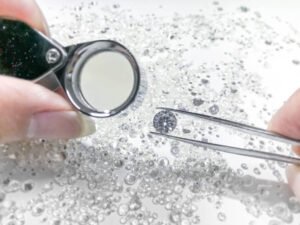Yes, Moissanite can be mistaken for a diamond by standard diamond testers.
Moissanite is a lab-created gemstone that closely mimics the thermal conductivity of diamonds, which can cause it to register as a diamond on heat-based testers. However, while the two materials have similar heat conductivity, they are not identical. More sensitive diamond testers can detect the subtle differences between Moissanite and natural diamonds.
Differences Between Moissanite and Diamonds

Visually, Moissanite may have a slightly different brilliance compared to diamonds. Under certain lighting conditions, it can reflect hues of yellow or green, though these differences are usually so subtle that they’re hard to spot unless placed side-by-side with a diamond.
Cost Comparison

One major reason for Moissanite’s popularity as a diamond alternative is its cost. Moissanite is approximately 90% less expensive than diamonds of similar size and quality. This makes it a very attractive option for those seeking the sparkle of a diamond at a fraction of the price.
Understanding Diamond Testers

1. How Diamond Testers Work
Diamond testers generally rely on thermal or electrical conductivity to determine whether a stone is a real diamond. Diamonds have excellent heat conductivity, and when the probe of a tester touches a real diamond, the tester will light up, confirming authenticity.
If the gem doesn’t conduct heat well, it’s likely not a diamond. Heat-conductivity testers are especially useful for distinguishing diamonds from imitations like cubic zirconia, which don’t have the same heat-dissipating properties.
2. Applicability to Other Gems
Diamond testers are designed specifically for diamonds and can also be used for Moissanite in some cases. However, these testers are generally not suitable for other gemstones, such as rubies, which have different conductivity properties. This specificity is critical when distinguishing between gems with similar visual characteristics.
3. What to Look for When Purchasing a Diamond Tester
For professionals or consumers using a diamond tester frequently, ease of use and comfort are essential features. Advanced models can also detect metals to avoid false readings from touching the setting. Moreover, some testers can differentiate between natural and lab-grown diamonds, treated diamonds, and even synthetic gems that might pass basic testing.
Certain testers use short-wave UV light for more in-depth analysis, providing an additional layer of accuracy for identifying real diamonds.
4. Testing Fake Diamonds or Cubic Zirconia
Diamond testers are highly effective in distinguishing cubic zirconia from real diamonds due to cubic zirconia’s lower thermal conductivity. So, these testers will easily differentiate a fake diamond from the real one.
1ct – 3ct Moissanite Ring 925 Sterling Silver with 18K Gold Plated
What Is Moissanite?

Moissanite, also known as silicon carbide, was first discovered in 1893 by French chemist Henri Moissan while studying meteor samples in Arizona. Natural Moissanite is extremely rare, often found in ultrabasic rocks and meteorites. Most Moissanite used today in jewelry is lab-grown, offering a sustainable and ethical alternative to natural gemstones.
Due to its extreme hardness, second only to diamonds, Moissanite is popular in both jewelry and industrial applications.
How to Tell Moissanite Apart from Diamonds
When comparing Moissanite and diamonds side by side, they are nearly indistinguishable. To the naked eye, high-quality Moissanite is almost impossible to tell apart from a diamond. However, one key difference is Moissanite’s enhanced brilliance. Moissanite tends to sparkle more intensely than diamonds due to its higher refractive index and double refraction properties.
When light enters a double-refractive stone like Moissanite, it splits into two beams, creating more intense light reflection. This results in more vibrant flashes of color, sometimes referred to as a “disco ball effect,” especially in larger stones. While this isn’t necessarily a drawback, it’s a distinctive feature that can set Moissanite apart from diamonds in certain light conditions.
4 Reasons to Choose Moissanite Rings Over Diamonds

For decades, diamonds have been the traditional choice for engagement rings. However, more and more people are choosing Moissanite engagement rings as a stunning, cost-effective alternative to diamonds. Here are four reasons why a Moissanite ring might be a better choice than a diamond:
1. Affordability
Moissanite rings are significantly less expensive than diamond rings. While a one-carat diamond can range from $5,000 to $25,000, a one-carat Moissanite ring costs between $400 and $800, with prices potentially even lower for direct-from-factory purchases. This cost-saving allows you to invest in other important aspects of your wedding or future together.
2. Durability
Moissanite is more durable than diamonds. With a hardness rating of 9.25 (compared to diamond’s 10), Moissanite is resistant to scratching and chipping, making it perfect for everyday wear.
3. Visual Appeal
Moissanite has a higher refractive index than diamonds, meaning it exhibits more fire and brilliance. This gives Moissanite rings a dazzling and unique look that will catch anyone’s eye.
4. Ethical Considerations
The diamond industry has long been associated with unethical practices, such as conflict diamonds. Moissanite, on the other hand, is a sustainable and ethically sourced choice. Moissanitejew offers conflict-free and eco-friendly Moissanite, ideal for those who value environmental and ethical practices.
In conclusion, Moissanite rings are a stunning and affordable alternative to diamond rings, offering additional benefits like durability, visual appeal, and ethical sourcing. Consider a Moissanite ring for your engagement or wedding to save money while still enjoying a beautiful and unique piece of jewelry.
References:
- Warr, L.N. (2021). “IMA–CNMNC approved mineral symbols”. Mineralogical Magazine. 85 (3): 291–320. Bibcode:2021MinM…85..291W. doi:10.1180/mgm.2021.43. S2CID 235729616.
- ^ Moissanite. Webmineral
- ^ Moissanite. Mindat
- ^ Jump up to:a b Anthony, John W.; Bideaux, Richard A.; Bladh, Kenneth W. and Nichols, Monte C. (eds.) “Moissanite” Archived 2016-03-03 at the Wayback Machine. Handbook of Mineralogy. Mineralogical Society of America
- ^ “Moissanite”. Oxford English Dictionary (Online ed.). Oxford University Press. (Subscription or participating institution membership required.)
- Wikipedia: Moissanite


